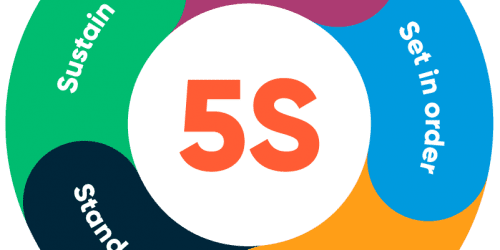Kaizen method: how to continuously improve your company’s performance
Lean Six Sigma is a method of continuous improvement that involves all actors in a process to eliminate waste, i.e. anything that reduces the efficiency and performance of a production unit or the entire company.
This approach is based on another work optimisation method: the Kaizen system. Originating in Japan, it is now successfully used worldwide by many companies in all sectors. So, what is the Kaizen method? What are its advantages and how can you implement it? This article provides the answers to all these questions.
Definition: What is the Kaizen method?
A fusion of the Japanese words “kai” and “zen” (meaning “change” and “good” respectively), the Kaizen method focuses on the continuous improvement of company performance as well as the optimisation of employees’ time and working conditions.
The implementation of abrupt changes in management systems can be a psychological hindrance for many employees. The Kaizen method instead consists of a multitude of tools and small, simple, concrete and inexpensive tasks to help achieve the set objectives.
What we ask employees is simply that they ask themselves questions: “Why am I doing this?”, “What are my customer’s needs?”, “How can I improve my process and meet their needs in a simple and efficient way?”.
This system therefore relies, above all, on the strong commitment of the employees concerned to devising the ideas, means and tools for continuous improvement in all sectors of the company (finance, production, administration, product development, etc.).
The method is divided into several steps. We first identify the problem: what difficulty do I have in my current process. To respond to this, you can, for example, work on order processing times. There is a process known as “Kaizen Blitz”, a version of the method condensed into three days. It is applied for simple processes, which involve two or three departments.
The main feature of Kaizen Blitz is fun. Games, videos, Post-it notes, arrows, a large airy room with flip charts, colourful markers, space to move around the room freely, etc. The major advantage of Kaizen Blitz is that, the very next morning, the new process can be put in place and its impact analysed. Of course, this method is not just a three-day project, but it brings about improvements in everyday life. The team takes the initiative to ask questions in the context of this new approach.
Kaizen method continuous improvement tools
The Kaizen method makes use of several management tools to improve quality of life at work:
- The 5S method, which makes better use of time and optimises working conditions;
- SMED (Single Minute Exchange of Die), which consists of optimising transitions in production and eliminating downtime;
- TQM (Total Quality Management), which focuses on production conditions and the quality of the product or service;
- Lean Management, which aims to improve inventory management and reduce losses and waste as much as possible;
- The Deming Wheel, whose 4-step process (Plan, Carry out, Predict and Act) leads to continuous improvement in productivity at work.
What are the main principles to follow to set up the Kaizen method?
To be effective, the Kaizen system requires a number of principles and conditions to be met:
- Constant reappraisal, even when things are going well, in order to remain competitive in the long term;
- Not aiming for perfection and setting realistic and gradual goals for change;
- Identifying the problem(s) causing the dysfunction in order to resolve it;
- Resolving problems as soon as possible so as not to let the situation escalate;
- Prioritising the changes to be made, for instance, by creating lists, is advisable to ensure that the system is implemented in the best possible way;
- Being aware of the time needed to implement the new working policy and putting into perspective the mistakes that can be made;
- Involving all team members to achieve coordinated results over time and continuous improvement in productivity.
How to put the Kaizen method in place
Following the theoretical definition, let us now consider the practical implementation of the tools of this method of management in companies and the optimisation of working conditions.
Analyse the causes and find solutions together
The priority is to map each process, step by step, with all their details and timescales. Teams are often surprised at the complexity of the processes they use on a daily basis and the inherent waste of time.
Next, it is necessary to identify the causes of the dysfunctions observed. There is a method known as “The 5 Whys”, which helps you find the root causes of problems.
Apply the main steps of the process
The implementation of the Kaizen method is based on 6 main steps:
- Define the problem;
- Measure its scale (mapping of the process, supplemented by statistics, timescales);
- Analyse the causes of the dysfunctions;
- Define breakthrough solutions as well as changes that can be made to the system;
- Evaluate the relevance of the measures taken and the tools used, and define, if necessary, areas for improvement for this new system;
- Implement and sustain the process in the long term.
Secure and sustain this strategy for continuous improvement
In its implementation, the Kaizen method relies in particular on visual management: once defined, the tasks to be accomplished are “materialised” in the form of lists, tables or diagrams which are then displayed on a wall or a flip chart to make them easier to understand and remember. This visual aspect also helps to instil the system among staff and to monitor performance.
The concrete results of the Kaizen method
The successful application of the Kaizen method leads, in the medium term, to positive changes and results at several levels of the company:
- It significantly optimises the working conditions of employees and contributes to greater staff engagement;
- It enables continuous improvement of productivity and optimisation of time and production schedules;
- The system ultimately guarantees that the products or services sold are of better quality.





